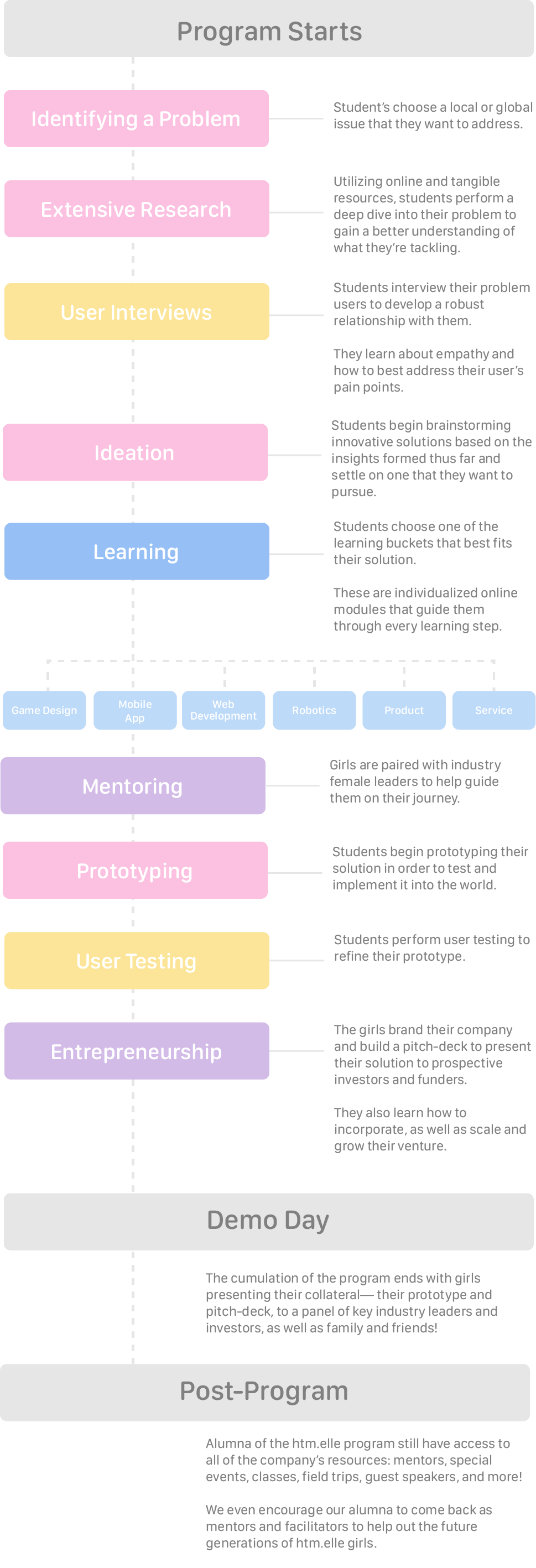htm.elle
A non-profit dedicated to creating the next generation of female founders. htm.elle works with girls from neglected communities to empower them to “conquer all” through an instructional program blending engineering, design, cognitive science, and marketing. It’s a sisterhood that works with young women on every step of the entrepreneurial process - from ideation all the way to fruition.
The Problem
Create a thorough, flexible program to teach middle/high school girls design
My Role
Initially brought on as the sole Creative Advisor, I also became a co-facilitator working with girls in the classroom. With the help of the team, I led a redesign of the program structure.
Research
To develop a flexible program, I needed to understand a few things, some of which were also learned in the classroom:
How does htm.elle facilitate the program?
What are the age ranges for the girls and what are their motivations?
What may be the community girls are coming from? How can we relate to them?
Insights
Keep the language simple
Challenge the girls, but don’t make concepts out of reach
Allow girls to learn by doing
Make it easy to understand how all the topics relate
Allow girls to choose their own topic, or pick from local topics suggested by the partnered school
How Might We create in inclusive, accessible program for motivated girls to learn how to run a start-up?
Concept
While the pilot program conducted in Summer of 2019 was effective, I found a gap in the shift between topics: design, engineering, and cognitive science. Instead of learning topics individually, I asked how we can extract the similarities of each topic to teach more holistically. Through the development of this idea, I created a new structure for the program that was based on the appropriate blend of information in a Design Thinking process.
The team and I worked through lesson plans to discuss the natural flow of information and how topics would blend together while providing hands-on experience to practice learned skills.
Challenges
The first test of the revised program was on a group of talented girls from a school in Oakland. Unfortunately, as myself and the other co-facilitator discovered over the course of the program, the priorities of the girls were not aligned with the anticipations the non-profit was leading with. With the new need of shifting our program to align with the girls while the program was already in motion, we faced a challenging road ahead.
the girls are motivated to learn, but they have so many extracurriculars, jobs, and other commitments that homework wasn’t being completed
many of the girls have English as the second language, so even the simplified English used, was sometimes too complicated
due to other commitments (jobs, church, sports, and teacher office hours), we had to revise our attendance policy, so teaching with varying attendance made it difficult to keep moving forward
Solution
Although the girls viewed the program as a fun learning experience, we ended up shifting from in-person to online classes to allow students the flexibility of work, sports, church, and teacher office hours. While the solution was not the best, we made the most of it. Girls were able to take the class at their own pace, reach out for help, and present their work through a web-design lesson to build their own portfolio site!
Moving Forward
As my co-facilitator and I discovered on the job, we needed to have a better understanding of the backgrounds and communities the girls come from, in addition to their motivations and priorities. With these in mind, we can better cater the program to fit the current needs and both parties can successfully meet expectations.





